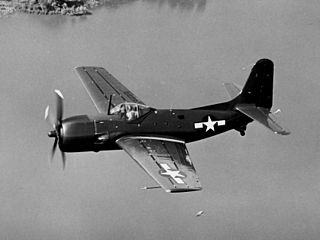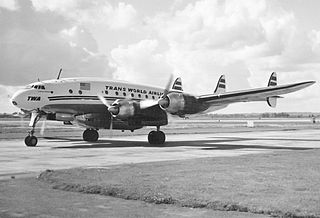Related Research Articles

The Wright R-3350 Duplex-Cyclone is a twin-row, supercharged, air-cooled, radial aircraft engine with 18 cylinders displacing nearly 55 L. Power ranged from 2,200 to over 3,700 hp, depending on the model. Developed before World War II, the R-3350's design required a long time to mature before finally being used to power the Boeing B-29 Superfortress. After the war, the engine had matured sufficiently to become a major civilian airliner design, notably in its turbo-compound forms, and was used in the Lockheed L-1049 Super Constellation airliners into the 1990s. The engine is commonly used on Hawker Sea Fury and Grumman F8F Bearcat Unlimited Class Racers at the Reno Air Races. Its main rival was the 71.5 L, 4,300 hp (3,200 kW) Pratt & Whitney R-4360 Wasp Major, first run some seven years after the Duplex-Cyclone's beginnings.

The Martin P5M Marlin, built by the Glenn L. Martin Company of Middle River, Maryland, was a twin piston-engined flying boat that entered service in 1951, and served into the late 1960s with the United States Navy performing naval patrols. It also served with the United States Coast Guard and the French Navy. 285 were produced.

The Douglas YOA-5 was an Amphibious aircraft designed for the United States Army Air Corps. Although a prototype was built, it did not enter production.

The Douglas XB-19 was the largest bomber aircraft built for the United States Army Air Forces until 1946. It was originally given the designation XBLR-2.

The Lockheed XB-30 was the design submitted by Lockheed after the request by the United States Army Air Forces for a very heavy bomber, the same request that led to the Boeing B-29 Superfortress, the Douglas XB-31 and Consolidated B-32 Dominator.
The Douglas XB-31 was the design submitted by Douglas after the request by the United States Army Air Forces for a very heavy bomber aircraft, the same request that led to the Boeing B-29 Superfortress, Lockheed XB-30, and Consolidated B-32 Dominator.
The Martin XB-33 Super Marauder was a proposed World War II American bomber aircraft. It was designed by the Glenn L. Martin Company as the Martin Model 190 and was a high-altitude derivative of the company's B-26 Marauder. Two different designs were developed, first as a twin-engined aircraft and then as a four-engined aircraft. The four-engined version was ordered by the United States Army Air Forces, but the program was cancelled before any aircraft were built.

The Boeing XPBB-1 Sea Ranger was a prototype twin-engined flying boat patrol bomber built for the United States Navy. The order for this aircraft was canceled, to free production capacity to build the Boeing B-29, and only a single prototype was completed.

The Curtiss XP-62 was a prototype single-engine interceptor aircraft, that was built at the request of the United States Army Air Forces, by the Curtiss-Wright Corporation. It first flew in 1943.

The Curtiss XF14C was an American naval fighter aircraft. It was developed by Curtiss-Wright in response to a request by the United States Navy in 1941 to produce a new shipboard high-performance fighter aircraft.

The Sikorsky VS-44 was a large four-engined flying boat built in the United States in the early 1940s by Sikorsky Aircraft. Based on the XPBS-1 patrol bomber, the VS-44 was designed primarily for the transatlantic passenger market, with a capacity of 40+ passengers. Three units were produced: Excalibur, Excambian, and Exeter, plus two XPBS-1 prototypes.

The Wright R-1300 Cyclone 7 is an American air-cooled seven-cylinder supercharged radial aircraft engine produced by Curtiss-Wright.

The Consolidated XP4Y Corregidor was an American twin-engined long-range maritime patrol flying boat built by Consolidated Aircraft for the United States Navy. Only one was built and a production order for 200 was cancelled.

The Curtiss XBTC was a prototype single-seat, single-engined torpedo/dive bomber developed during World War II for the United States Navy. Four aircraft were ordered, powered by two different engines, but the two aircraft to be fitted with the Wright R-3350 radial engine were cancelled in late 1942, leaving only the pair using the Pratt & Whitney R-4360 radial. By this time, Curtiss Aircraft was overwhelmed with work and the Navy gave the XBTC-2 prototypes a low priority which delayed progress so the first flight did not take place until the beginning of 1945. One aircraft crashed in early 1947 and the other was disposed of later that year.

The Curtiss XBT2C was a prototype two-seat, single-engined dive/torpedo bomber developed during World War II for the United States Navy. Derived from the Curtiss SB2C Helldiver dive bomber, it was an unsuccessful competitor to meet a 1945 Navy specification for an aircraft to combine the roles that previously required separate types. Unlike the other competitors, the XBT2C was designed to accommodate a radar operator.

The Sikorsky S-36 was an eight-seat amphibian sesquiplane designed and built by the Sikorsky Manufacturing Company in the late 1920s. The aircraft was ordered by Pan American Airways, the start of a long association with Sikorsky flying boats.

The Lockheed C-69 Constellation was a four-engined, propeller-driven military transport aircraft developed during World War Two. It was co-developed with the Lockheed Constellation airliner.
The Sikorsky S-34 was a 1920s American six-seat sesquiplane, designed and built by the Sikorsky Manufacturing Corporation. Only one was built, but the design led to the successful Sikorsky S-38.

The Lockheed L-649 Constellation was the first real civilian version of the Lockheed Constellation line, as the Lockheed L-049 Constellation was a simple redesign from the military Lockheed C-69 Constellation. The L-649 was planned to be the new standard version of the Constellation, but the L-749 Constellation, a co-jointly produced improved derivative, was chosen over the L-649 by most airlines. Most of the few L-649 aircraft built were delivered and operated by Eastern Air Lines.

The Lockheed L-749 Constellation is the first Lockheed Constellation to regularly cross the Atlantic Ocean non-stop. Although similar in appearance to the L-649 before it, the L-749 had a larger fuel capacity, strengthened landing gear, and eventually weather radar.
References
- 1 2 "Sikorsky S-45 Flying Boat". www.globalsecurity.org. 2017. Retrieved 19 May 2017.
- ↑ "The American Fixed Wing Era". www.sikorskyarchives.com. Sikorsky Archives. Retrieved 14 May 2017.
- 1 2 3 Johnson, E.R. (2009). American Flying Boats and Amphibious Aircraft: An Illustrated History. Jefferson, North Carolina: McFarland & Company, Inc., Publishers. p. 340. ISBN 978-0-7864-3974-4.